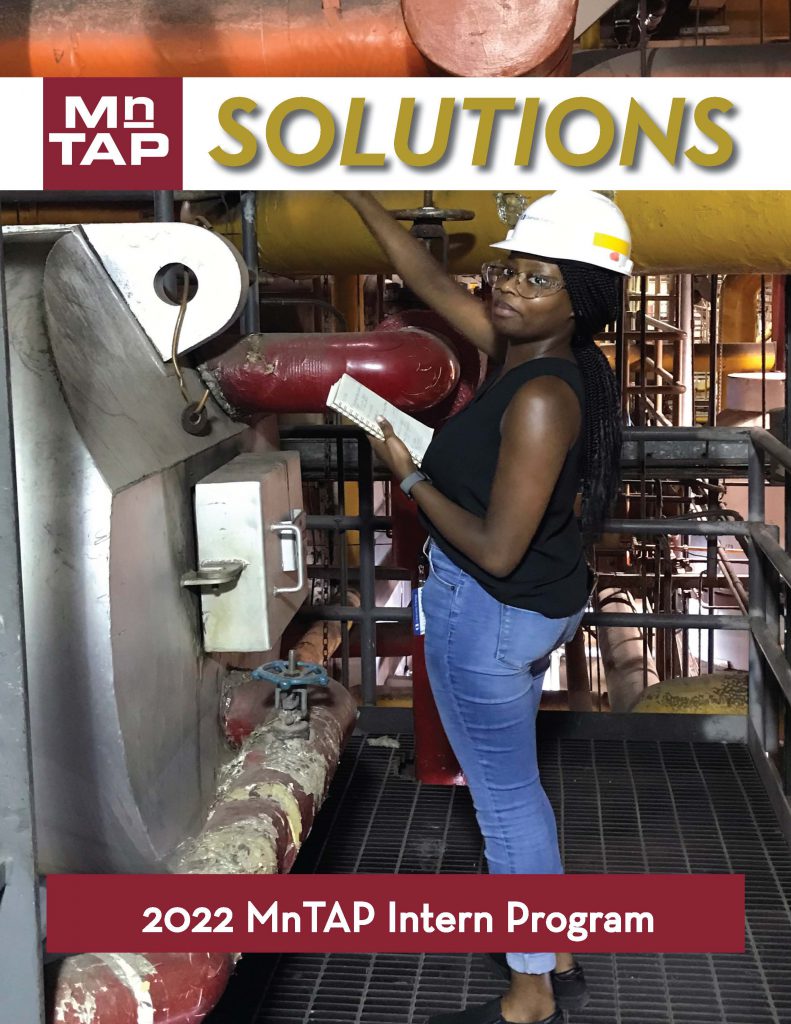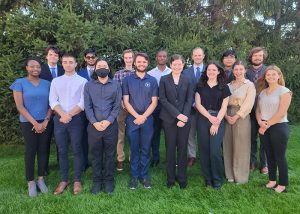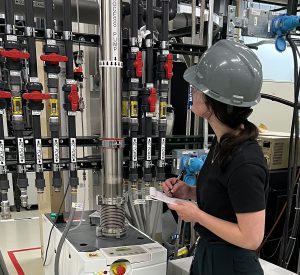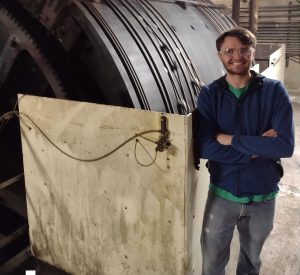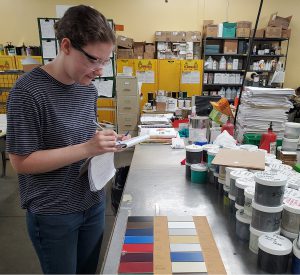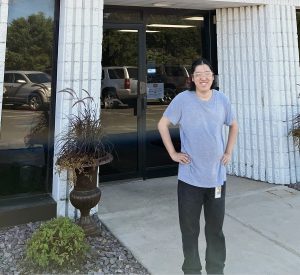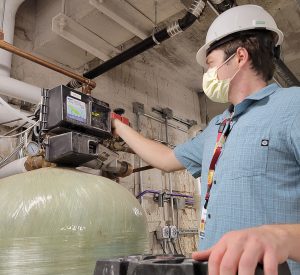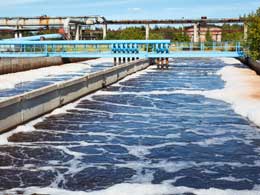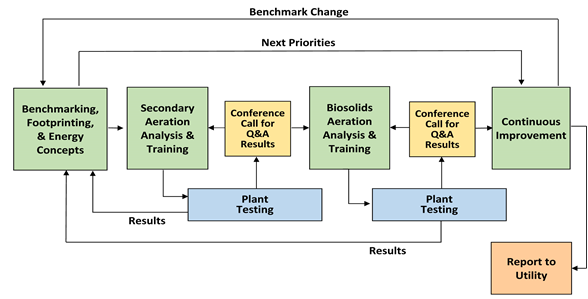November 2022
Inside the Newsletter:
2022 Solutions | Water Efficiency Projects | Waste Reduction Projects | Energy Saving Projects | WWTP Training
2022 Solutions for Minnesota Businesses!
MnTAP is proud to announce the publication of the 2022 Solutions. This annual report highlights the results from our summer internship program. This year our cohort of 16 talented and industrious interns identified environmental reductions and process improvements that could save their companies:
- 68,700,000 gallons of water, saving $627,000
- 5,980,000 kWh electricity, saving $486,000
- 556,000 therms of energy, saving $627,000
- 742,000 pounds of waste, saving $588,000
- 70,000 pounds of chemical waste, saving $26,000
- $684,000 in production impacts
When implemented, these reductions have the potential to save companies $3,038,000 annually!
These results translate into real environmental impacts equivalent to eliminating CO2 emissions from 625 passenger vehicles and powering 630 Minnesota homes. Saving water equivalent to the water use for approximately 3,000 Minnesota residents. Eliminating 140 55 gallon drums of chemical use.
We hope that as you read about the 2022 MnTAP intern projects and the results achieved, you will be inspired to contact MnTAP to learn how your company can benefit from having an intern at your site to maximize resource efficiency, increase energy efficiency, reduce costs, and prevent pollution.
Now is the Time to Apply for YOUR 2023 Intern!
The MnTAP intern program pairs manufacturing, food processing, hospitality and other facilities in Minnesota with a college student who researches and recommends water conservation, energy efficiency and pollution prevention solutions. MnTAP interns have helped identify opportunities that save participating companies millions of dollars annually.
If your company could use another set of eyes to achieve similar results, now is the time to start thinking about developing a project for the summer of 2023. We anticipate supporting up to 15-18 projects that could focus on water conservation, energy efficiency, paint efficiency, solid waste, and pollution prevention.
Applications are currently being accepted and will be reviewed upon receipt. Companies will be contacted by MnTAP technical staff within two weeks for additional project development and scoping. Although applications are accepted through January 2023, companies are encouraged to apply by the end of 2022 to provide enough time to scope a well-defined project at their facilities.
For more information about the intern program or the application process, visit the MnTAP Intern Program webpages for Businesses. Use the Apply link to the Intern Company Application.
For More Information, Contact:
Matt Domski – Intern Project Manager
612-624-5119
mdomski@umn.edu
Water Efficiency Projects
The 2022 MnTAP Interns observed processes and conducted research to show how the costs and impacts of consuming water can add up quickly for their companies. With economic and environmental impacts in mind, interns identified new ways to conserve more water in company operations and improve the efficiency of their facilities. MnTAP Interns help companies optimize water use, avoid additional charges associated with water use, and reduce environmental impact.
Megan Tardoni
Bioproducts & Biosystems Engineering – University of Minnesota Twin Cities
This summer, Megan worked at Seagate Technology, a producer of data storage technology at the Bloomington, MN campus. Her project was to investigate options for improving water use to support the company’s sustainability goals. The facility uses high purity water for many operations. The water purification process produces a reject stream that is currently sent to drain. A chemical analysis found the reject stream was relatively pure, holding a lower concentration of minerals than the incoming city water. The recommendation is to recycle this water purification reject stream back through the high purity water process. This will result in 1.5 million gallons of water saved annually, as well as a decrease in the volume of processing chemicals needed when fully implemented.
Shane Johnson
Chemistry & Environmental Studies – Macalester College
Twin City Tanning Company, LLP, located in South St. Paul, MN, processes raw cattle hides in the first stage of the leather tanning process. Leather tanning and manufacturing is an inherently water intensive process. Shane was hired to seek ways to decrease water use, improve wastewater effluent quality and save operating costs for the business. Tanning drums use approximately 28% of all daily water and nearly 24% of this water can be recycled. There was a system in place to recycle this water after on-site pre-treatment, however, it was not operational. The recommendation is to conduct the needed maintenance on the system and reimplement recycling of the tanning drum water. TCT will be able to reduce their annual water usage by 7,900,000 gallons and save $174,000 annually once the project is complete.
Waste Reduction Projects
There are many wastes streams that come from various industries. Many of our 2022 interns focused on ways to reduce waste at their facilities. These changes could include redesigning process inputs to use fewer raw materials, switching to less hazardous products to reduce pollution, and replacing single use products with those that can be reused many times. All of these strategies were incorporated in the intern recommendations this summer to avoid hazardous waste emissions, reduce material use and decrease solid waste generation.
Nathan Miller
Chemical Engineering – University of Minnesota Duluth
This summer Nathan worked at Mustad USA, the leading manufacturer of steel horseshoes in North America. One focus of his project was reducing steel consumption at the facility as it was found that over 30% of the processed steel became scrap. Four material-focused changes were recommended. Increase the horseshoe die lifetime by selecting more specialized steel to manufacture the dies. In addition to changes to the die material, it was recommended to adjust the dies to better match the horseshoe dimensions. A material change was recommended for punch tools to better match use temperature requirements. An opportunity to decrease the crop length used by process robots to hold parts was identified. Combined, these material changes are estimated to save almost 27 tons of steel annually when fully implemented.
Madeline Danforth
Chemical Engineering – University of Minnesota Duluth
Advance Corporation, located in Cottage Grove, MN, manufactures way finding braille signage and custom awards. The company began working with Environmental Initiative to explore air emission reductions from painting and finishing operations and was referred to the MnTAP Intern Program. Part of Madeline’s project was to assess the environmental performance and savings opportunity for switching to a lower emissions paint system such as those with VOC-exempt solvents or higher solids content. Comparison of price and performance for various paint systems identified a suitable alternative that carried an additional benefit of providing color matching software to reduce the time spent manually matching colors. The recommendation to change the paint system would carry a VOC reduction of 1,570 lbs and save $18,000 in labor costs. The company is also able to explore grant funding for the project through Ramsey/Washington Recycling & Energy to offset some of the equipment costs.
Energy Saving Projects
Energy efficiency is a significant focus area for MnTAP interns. Projects can be focused directly on energy assessments and creating recommendations specifically focused on equipment or process modifications that will directly lead to improved energy utilization at a facility. Interns often find that energy savings can be embedded within the results of other types of recommendations such as those made around water conservation or material savings. Energy savings by MnTAP interns can be large or small and they often help financially justify process changes recommended for improved environmental performance.
Devin Fleck
Mechanical Engineering – St Cloud State University
Miller Manufacturing produces farm and animal care products and has been exploring opportunities for energy efficiency in their facility. Devin was able to identify and quantify the impact of several recommendations to conserve heat energy in the building. One recommendation is to maintain the dock leveler sweeps to improve weather seals on loading dock doors. Installing energy saving dock hinges that push the dock door flush against the wall and close gaps can minimize heat loss. Miller can also use temperature controls to set different building temperatures for occupied and unoccupied parts of the day, while utilizing the most efficient radiant heating units preferentially. Occupancy sensors can also minimize conditioned air loss from the building. Combined, these recommendations are estimated to save nearly 10,000 therms of natural gas energy and $9,200 annually when fully implemented.
Thomas Stocking
Mechanical Engineering – University of Minnesota Twin Cities
Thomas supported a project at M Health Fairview, a health services provider, at their University of Minnesota Medical Center, West Bank Campus. This hospital campus has been serving patients for over 100 years. The project was focused on identifying opportunities to save resources and help reduce the impacts of climate change. When steam traps fail, the resources that go into creating the steam are wasted. A steam trap survey identified 27 failed steam traps. By repairing or replacing the failed traps, the hospital would save 140,000 therms of natural gas, 650,000 gallons of water, and $190,000 a year. A related recommendation was to reinstate yearly steam trap surveys to quickly identify, repair or replace broken traps to maintain optimal steam trap performance.
Energy Savings for Wastewater Treatment Plants: Cohort Training Program
Objective
The Minnesota Technical Assistance Program (MnTAP) is offering a cohort based training focused on identifying and implementing low and no cost improvements that reduce energy consumption at wastewater treatment plants (WWTPs), without sacrificing plant effectiveness at meeting discharge limits.
Target Audience
Lead wastewater treatment plant operators at municipal WWTPs treating flows up to 10,000 MGD
What You Will Learn
The course will teach wastewater operations staff the basics about energy use in their facilities, assist them in implementing the first energy conservation project and leave the operations staff with a tangible plan for continuous energy efficiency improvement.
Training will be conducted with a cohort of five WWTP operators that are located in the same geographic area. There are four in person training modules and two conference calls to assess site energy use and develop energy efficiency strategies.
Training topics include:
- Energy benchmarking using B3 – learn how your site compares with other for energy use
- Secondary Aeration Analysis and Training – identify strategies to optimize blower performance
- Biosolids Aeration Analysis and Training – identify strategies to optimize blower performance
- Continuous Improvement – develop a site action plan for future energy efficiency opportunities
See the program website for more information on the training program and a registration form or contact Jon Vanyo, jvanyo@umn.edu, 612-624-4683.
